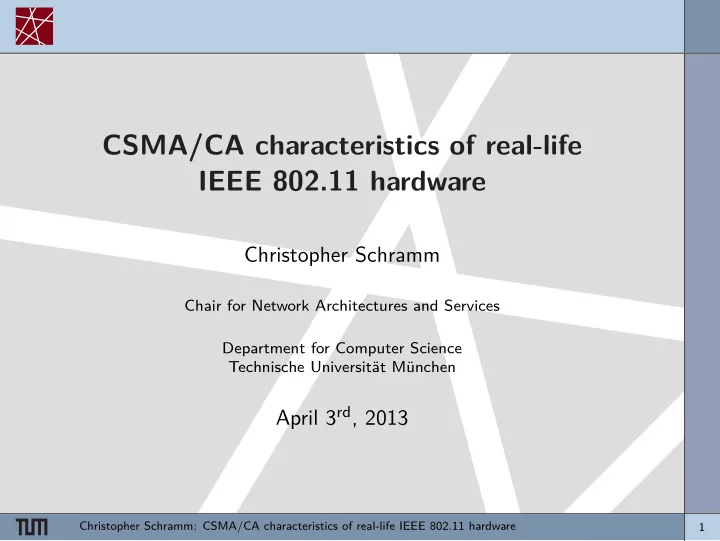

. . CSMA/CA characteristics of real-life IEEE 802.11 hardware Christopher Schramm Chair for Network Architectures and Services Department for Computer Science Technische Universität München April 3 rd , 2013 . Christopher Schramm: CSMA/CA characteristics of real-life IEEE 802.11 hardware 1
. Outline 1 Background 2 Observations 3 Goals 4 Motivation / Use 5 References 6 Timeline . Christopher Schramm: CSMA/CA characteristics of real-life IEEE 802.11 hardware 2
. Background Christopher Schramm: CSMA/CA characteristics of real-life IEEE 802.11 hardware . window, which increases with failed transmissions Random() = Pseudorandom integer taken from contention 3 between detecting a free medium and sending Distributed Coordination Function (DCF) CSMA/CA requires a sender to wait for a random backoff time IEEE 802.11 uses CSMA/CA to avoid collisions DIFS Contention window SIFS Busy medium Backoff slots Next frame Slot time Defer access Backoff interval BackoffTime = Random() × aSlotTime
. Observations Christopher Schramm: CSMA/CA characteristics of real-life IEEE 802.11 hardware . independent statistically Ralink is at least not no randomness at all Broadcom chip has 4 Hardware / driver vendors want their design to... ...be simple and cheap. ...possibly perform better than other devices. During his analysis of monitoring and injection capabilities, Stephan found these injection delays: 30 AR9380 AR9280 BCM43224 25 RT2870 Injection delay [ ms ] 20 15 10 5 0 0 100 200 300 400 500 600 700 800 900 1,000 Echo request SEQ
. Is this fair? Christopher Schramm: CSMA/CA characteristics of real-life IEEE 802.11 hardware . streams among STAs. statistical independence among the random number It is important that designers recognize the need for IEEE 802.11 9.3.3: Neither is it clever. 5 Is this fair? ⇒ No! 55 50 T X A → B 45 Achievable rate [Mbit/s] R X A → B 40 T X A ← B 35 30 R X A ← B 25 T X A A ↔ B 20 T X B A ↔ B 15 R X B A ↔ B 10 5 0 AR9280 AR9380 BCM43224 RT2870 BCM43224 RT2870 RT2870 AR9280 AR9280 BCM43224
. Goals We want to further analyze those characteristics for real-life hardware in several steps: Monitor Mode Remote observation Managed Mode (needs remote observation) Different drivers / operating systems (Are observed anomalies related to specific driver / OS / hardware?) An overall ”bonus” goal would be to implement a sniffer that detects hardware, OS and / or driver by looking for specific characteristics in observed traffic. . Christopher Schramm: CSMA/CA characteristics of real-life IEEE 802.11 hardware 6
. Motivation / Use Monitor Mode characteristics need to be known when using frame injection, in our case for building of mesh networks Managed Mode characteristics may be of interest when choosing hardware for large network setups Detection may be of interest in security and administrative contexts to find vulnerable, flawed or deprecated hardware . Christopher Schramm: CSMA/CA characteristics of real-life IEEE 802.11 hardware 7
. References Primary reference: IEEE 802.11 T. Ho and K. Chen: Performance Analysis of IEEE 802.11 CSMA/CA G. Bianchi: Performance Analysis of the IEEE 802.11 Distributed Coordination Function E. Ziouva and T. Antonakopoulos: CSMA/CA Performance under High Traffic Conditions: Throughput and Delay Analysis . Christopher Schramm: CSMA/CA characteristics of real-life IEEE 802.11 hardware 8
. Timeline Monitor Mode: March and April Remote observation: May Managed Mode: June Different drivers / OSs: July Detection by characteristics: August Last two weeks dedicated to finishing the thesis . Christopher Schramm: CSMA/CA characteristics of real-life IEEE 802.11 hardware 9 Official schedule: March 15 th - September 15 th
Recommend
More recommend